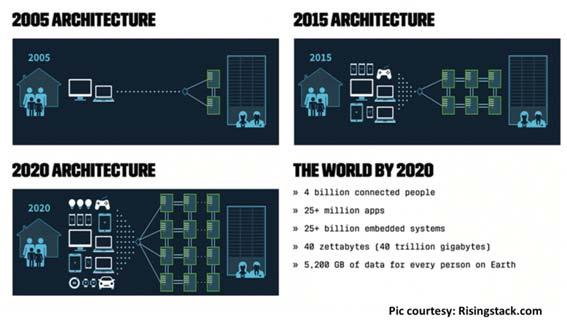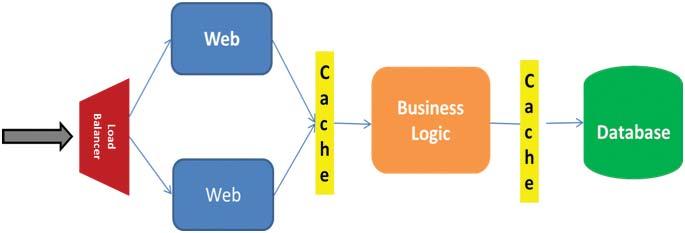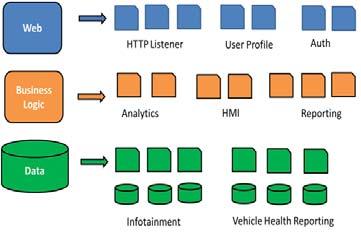
7 minute read
Assembling a Connected-Car Using MicroServices
Ragu Sivaraman
Founder MacMetry
Advertisement
Ragu Sivaraman was earlier instrumental in launching MacTrac, a two wheeler tracking product that augments a rider, a Dealer and/or Fleet provider to manage and monitor motorcycles in real Ɵ me using tracking device, mobile app and a cloud hosted reporƟ ng soluƟ on.
If a Connected Vehicle could talk, it will say “AV, you complete me!!” Welcome the Connected Autonomous Vehicle world (CAV) where the Connected Vehicle is all about supplying useful informaƟ on to a driver or to the Autonomous vehicle to help make safer or more informed decisions. CAV has high demands on the exchange of data and fi les between the connected car on the road, and a variety of scalable and agile services in the backend. This results in a soŌ ware services life cycle where in which the deprecaƟ on and deployment of new services must happen on a frequent basis. To solve these upcoming challenges, a scalable and fl exible architecture is required. Choosing Microservices as an architectural paradigm will enable us to achieve scalable and agile CAV backend that provides with increased operaƟ onal effi ciency and code quality.
CAV-Architecture Building Blocks
When it comes to connecƟ ng drivers and technology, the auto industry has a longer and richer track record than any other
sector. Although turning “connected car” into a signifi cant revenue generator has remained sketchy, its role in the AV (Autonomous Vehicle) world is pivotal and will make the car safer, faster, and more effi cient. Furthermore, virtually all autonomous vehicles will require connecƟ vity to ensure that their soŌ ware services and data sets are current. While the CAV has been the most prominent example of IoT these days, the cars as such are increasingly becoming soŌ ware driven and the real cloud based IoT developments in the auto industry are happening behind the scenes.

OEMs or the soluƟ on provider must address the complexity of behind the scenes soŌ ware development requirements with IoT centric use cases in mind. Some of the key points include: • Scalability: Some soŌ ware components are more oŌ en used and/or more resource intensive than others, resulƟ ng effi cient ways to replicate specifi c components necessary • Loosely Coupled: Components in major soŌ ware soluƟ ons can quickly become outdated. So it is important to fi nd a way of exchanging a component easily without aff ecƟ ng other components • Reuse: Many projects use similar soŌ ware features to work within the cloud. So a set of standard services used among mulƟ ple projects must be idenƟfi ed
ConƟ nuous IntegraƟ on and
deployment: Features that are added to a service must be visible at once, so that compaƟ bility with other services can be tested automaƟ cally Code quality: The same code is used in diff erent projects. So the demands on soŌ ware code quality and genericity have increased
What are MicroServices?
Over the past decade, most applicaƟ ons were deployed using monolithic architecture design principles. This means in an applicaƟ on all modules, libraries, and inter-dependencies that exist in a single code base is deployed and,

importantly, scaled as a single unit. This architecture concept created a signifi cant impediment in the emerging IoT world. For ex: If a small piece of the applicaƟ on needs a change, the whole applicaƟ on has to be compiled, tested and deployed again. This means that all parts of the applicaƟ on have to undergo the soŌ ware development process even though most of the modules don’t experience any changes. This comes at big costs taking manpower, Ɵ me and IT resources and in most cases lead to delays. In addiƟ on, a monolith makes it diffi cult to ensure: • Scalability • Be Highly Available • Agile • ConƟ nuous Service Delivery To meet these challenges the applicaƟ on architecture must change from a big blob of monolith to an architecture design where complex applicaƟ ons are composed
of small, independent processes and services, each organized around individual capabiliƟ es and communicate with each other via language-agnosƟ c ApplicaƟ on Programming Interfaces – APIs. This soŌ ware architecture design paƩ ern is commonly called Microservices, where these services are primarily small and focus on compleƟ ng singular tasks.

In microservices architecture, one single MicroService can be updated and deployed in a stronger hardware without aff ecƟ ng other services. Also each MicroService can be developed and deployed in a diff erent language – Java, C, C++, Scala, Python, etc. Granular governance and decentralized data management where each MicroService label and handle data separately is also possible. Microservices architecture supports automated, integraƟ on with ConƟ nuous IntegraƟ on (CI) and ConƟ nuous Delivery (CD) pipelines allowing developers to safely and frequently evolve the applicaƟ on and scale-out to be nearly instantaneous, allowing an applicaƟ on to adapt to changing loads. Their loose coupling also means that each MicroService can scale independently


and can move enƟ re assemblies of Microservices from one deployment environment to another, thereby achieving infrastructure portability.
MicroServices in the IoT Automotive World
In an IoT AutomoƟ ve world the “Things” are most of the Ɵ mes the small machines with their own processor, operaƟ ng system and sensors and contain some (hardwired) logic. They can be communicated using some lightweight APIs. They are completely autonomous, run in their own process space and deliver a small service

which means a “Thing” is the ulƟ mate incarnaƟ on of a MicroServices living inside the car.
AutomoƟ ve IoT generates certain types of workloads that promote the adopƟ on of MicroServices in a container instead of virtual machines for a lightweight, loosely-coupled deployment. Containers encapsulate discrete components of applicaƟ on logic provisioned only with the minimal resources needed to do their job. Unlike virtual machines (VM), containers have no need for embedded operaƟ ng systems (OS) and calls are made for OS resources via an applicaƟ on programming interface (API). So when viewed through the lens of IoT requirements both Containers and Microservices have a high degree of relevance to be applied for the future IoT systems design. When an automobile manufacturer rolls out one or more connected car models, each car may have several user apps (NavigaƟ on, etc.), as well as several sensors that upload telemetry data to the manufacturer’s cloud. Also the manufacturer may want to update the soŌ ware on a frequent basis. In this type of situaƟ on we can use containers and microservices and reap the benefi ts of instanƟ aƟ ng one container (container in auto scaling group) per car. Furthermore, the OEM backend can even have one MicroService per individual sensor since the container technology can rise to this challenge, of scaling to hundreds of thousands of cars. If there is one MicroService per sensor, then an intelligent integraƟ on infrastructure that manages the telemetry messages and compress them, to opƟ mize message traffi c is required, since the communicaƟ ons link between the automobiles and the cloud is limited and is relaƟ vely expensive.
Achieving MicroServices
While Microservices are a product of soŌ ware architecture and programming pracƟ ces, the potenƟ al mistake in developing Microservices is ignoring the impact that Microservices can have on OperaƟ ons. Microservices architectures typically produce smaller, but more numerous arƟ facts that OperaƟ ons is responsible for regularly deploying and managing.
These deployments are called microdeployments. In order to accelerate the development and bridge the gap between microservices and microdeployments every OEM must nurture a DevOps culture within the organizaƟ on. DevOps is not a role. DevOps is a term that describes the mindset and the organizaƟ onal structures that are required to deeply integrate Development and OperaƟ ons for developing MicroServices based ApplicaƟ ons. At present, many Auto makers including Ford, Mercedes-Benz, and VW are acƟ vely adapƟ ng Microservices/Container architecture principles in developing IoT enabled apps for their vehicles. So with a bright future on the horizon, let’s welcome the soŌ ware assembly to the Vehicle ProducƟ on Assembly Line!!










